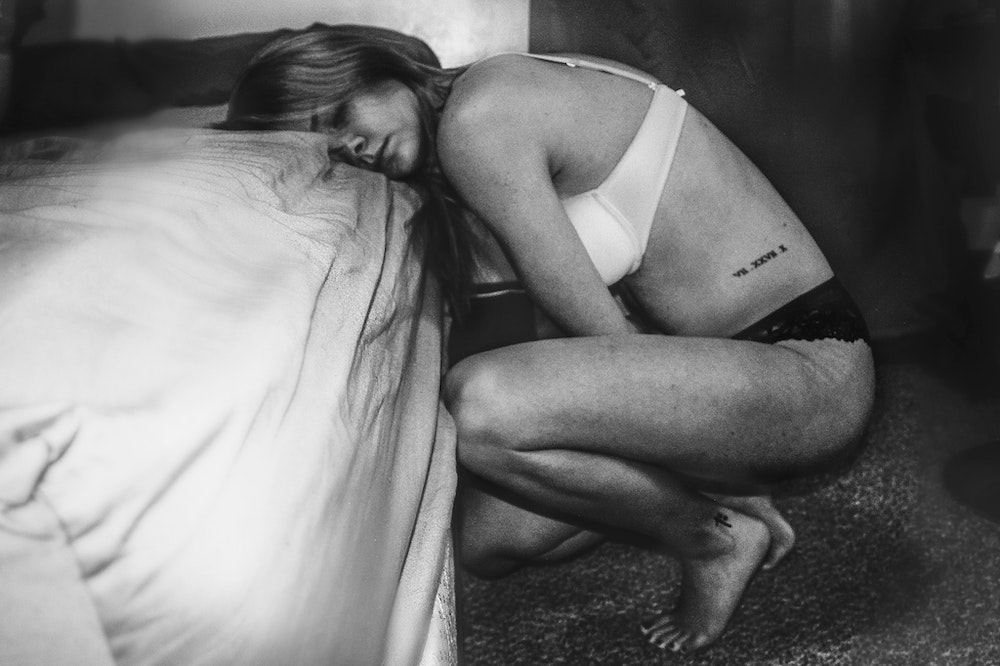Books & Culture
It’s Time to Destigmatize Talking Openly About What’s Going On Down There
Chloe Caldwell’s “The Red Zone” is the shame-free period story we need right now

When I started reading Chloe Caldwell’s new book, The Red Zone, a memoir about identity, love, health, and pain, all told through the lens of her relationship to her period, I didn’t think I had period hang-ups of my own to work through. I do have pudendal neuralgia, a nerve pain condition that I’ll get into more later. It doesn’t have anything to do with my period. But the treatment, in part, involves a pelvic therapist getting very up close and personal with everything going on down there, an experience that’s made me comfortable discussing—and sharing—my vagina.
Plus, I’m a 32-year-old woman with a tote bag that supports Planned Parenthood and a boyfriend I regularly send to the store for tampons, facts I assumed meant I was a well-adjusted human who’s not here for society’s period-shaming BS.
Which is all to say, when it comes to something as normal as my period, I thought: How could I have shame about that?
… Until I got my period while reading Caldwell’s book. Normally, that wouldn’t matter, but this time it was important because my boyfriend’s friend was staying with us for the week. And since I didn’t know if it’d be weird for me or uncomfortable for the friend if he noticed my tampon wrappers in the trash can, I decided to really bury them. But when you’re deep-diving through trash to hide the wrapper of a thing used by thousands of people every day, you have to wonder: Is this, maybe, a sign of shame?
From there, forgotten period stories from my life came back to me:
Like the time in high school when a girl who boys seemed to like better than me said that pads were gross because, “I mean, you’re just sitting in it. Ew.” And apparently I agreed that sitting in period blood was gross because I’ve been a tampons-only girl ever since. Shame. Or all the times growing up we pretended we had cramps to get out of gym or a test or swim practice, knowing the adult in the room would be too embarrassed to question us further. Shame. Because it had felt like we were using period stigma to our advantage. And maybe we were. But weren’t we also sort of reinforcing that stigma? And what about the fact that I’d never use my period as an excuse to get out of anything now? No matter how bad my cramps actually are, I just get up and get on with it because, I guess, I don’t think anyone really wants to hear about my period.
Nothing says deeply entrenched shame like the kind you’ve been conditioned to accept for so long that you don’t recognize it by its name. Because yes, of course, all of that is a kind of shame. But the way to deal with shame is to call it out, to normalize the experiences we’re embarrassed by or afraid of. Naming it helps us realize how stupid it is to hide tampon wrappers in our own trash. The way to deal with shame is to share our stories.
The way to deal with shame is to call it out, to normalize the experiences we’re embarrassed by or afraid of.
That’s exactly what Caldwell does for periods in The Red Zone. From bleeding on her boyfriend’s sheets to real talk about blood clots to sometimes hating her period unapologetically, she tells honest, shame-free stories about learning from, suffering through, and simply having a period. And in doing so, Caldwell gives readers the period story we deserve.
Caldwell’s book is specifically about her life with premenstrual dysphoric disorder, or PMDD, an extreme form of PMS that affects approximately 5.5% of women and AFAB individuals with periods, according to Caldwell’s book. Caldwell didn’t learn about PMDD growing up, which is at least partly why she struggled to make sense of the rage, paranoia, and sadness she started feeling each month after she turned 31, long after she got her first period. She calls these feelings her time in the Red Zone (hence the book’s title), and the book, big-picture, is about learning to understand and live with it in a way where it’s one smaller part of her life, not the thing taking over it.
In writing about PMDD, Caldwell takes what could be the lowest hanging fruit when it comes to degrading period humor—It’s a condition where women act like lunatics on their periods! The jokes write themselves!!—and gives it dignity. She still writes with plenty of humor about things like the rage-texts she sends her partner, Tony, mid-Red Zone, but she’s always in on the joke. And Caldwell takes her episodes seriously, too. Because of course not feeling in control of your body—or your emotions—is terrifying. Because of course emotions caused by period hormones are just as real as any others.
Not feeling in control of your body—or your emotions—is terrifying.
But you don’t have to have PMDD for Caldwell’s book to resonate. There’s plenty about regular ole’ menstruation, including a whole chapter dedicated to people sharing their own first-period memories, which touches on just about every emotion you can feel about a period, whether it’s embarrassed to tell your parents, confused about how to use the menstrual belts of yesteryears or tampons today, or just sick to your stomach with cramps.
There are also brilliant moments where Caldwell calls out the ridiculously half-hearted ways society educates people about periods. My personal favorite: Telling us heavy periods can be bad without actually telling us what a heavy period is. “At least in my middle school or high school, we were never handed three buckets of blood and told which one was light, regular, and heavy,” Caldwell writes as amusing but damning proof. With every story Caldwell shares, she chips away at the shame engrained in so many of us, shame we might not even have known was there.
The Red Zone is the most recent entry into a small but important group of titles working to destigmatize the period. TV shows like Amy Schumer’s Life and Beth, in which Schumer’s character is shown bleeding in the shower, or Michaela Coel’s I May Destroy You, where a love interest marvels at Coel’s bloody tampon and blood clot, show moments of Hollywood doing better. That’s compared to, say, 2007’s Superbad, where Jonah Hill’s character screams he wants to puke when period blood gets on him, or 1976’s Carrie, perhaps the most enduringly bad take on periods ever. Meanwhile, books with “PERIOD” splashed across the cover—such as Kate Farrell’s 2018 anthology—are popping up on TBR shelves, finding themselves part of Caldwell’s larger fight to rewrite the narrative of periods by putting real and honest stories out there.
But while reclaiming the period story is an important step, it’s not enough. When it comes to reproductive health, especially for women, there’s so many more stories we need to be better at telling. From pregnancy to menopause, endometriosis to abortion, these topics are the province of the unexplained, the unresearched, the badly covered. And all of that leads to erasure—many important stories not getting told at all. It leads to pain and curiosity and uncertainty being silenced and, ultimately, turned into shame.
In the case of abortion, it leads to an often-routine medical service being ripped away from those who need it most because a handful of judges say so; and increased inequity for non-white, non-straight, non-cis, non-wealthy people; and a general inability to acknowledge that people who can carry babies shouldn’t have to give up their own rights—and sometimes, their own lives—because of it.
But I digress. This is about stories. And shame. Which brings me to my body, my story.
My story is that for four years I’ve lived with nerve pain all over my feet, my shins, my thighs, my hips, my butt, and my vagina. It took four years of doctors’ visits and physical therapy, five so-labeled “unremarkable” MRIs, and countless injections and medications—none of which worked—to figure out that my pain stemmed from pelvic issues, even though chronic pelvic pain is a condition so common it affects an estimated one in seven U.S. women.
One specific source of my pelvic pain is an aggravated pudendal nerve, a.k.a. my aforementioned pudendal neuralgia. To be fair, this is a much less common condition than general chronic pelvic pain. Before I was diagnosed with pudendal neuralgia, I’d never heard of it. That’s probably because it’s the nerve that supplies sensations to our genitals and anus, words we don’t really like to talk about. If I’m being honest, I hated writing them here. But the fact that I feel that way is exactly the point and is very much the problem. When it comes to body shame, the pudendal nerve really is hall-of-fame worthy stuff. “Pudendal” comes from the Latin word pudere, which means to be ashamed. Truly, you can’t make this up.
When I sat in doctors’ offices for all of those years, I didn’t feel ashamed of my symptoms. I felt desperate for someone to help me.
To be clear, when I sat in doctors’ offices for all of those years, I didn’t feel ashamed of my symptoms. I felt desperate for someone to help me. And when a pelvic therapist finally explained that my pudendal nerve was the big issue, I didn’t feel shame then, either. I felt relieved to have an explanation.
But after reading Caldwell’s book, I’m wondering if it was that deeper kind of shame, the same kind of shame I didn’t realize I held about my period, that played a part in me not getting the help I needed for so long. You know, the kind of shame you’ve been conditioned to accept for so long that you don’t recognize it by its name.
For years, I told medical professionals that my nerve symptoms started in my foot. And I said that because I really thought they had. Now, I realize, what I meant was that when the nerve symptoms showed up in my foot, that’s when I decided they were something worth questioning. It was only after I got my pudendal neuralgia diagnosis that I remembered how, months before the foot symptoms showed up, my vagina would sometimes burn and itch for days. But why hadn’t I remembered that sooner? Why did I never think to mention my burning vagina to doctors?
And what about sex? Not every doctor asked me if I had pain during sex, but some did. In response, I always said I had none. And, always, I thought I was telling the truth. But it was also true that after I had sex, I would feel weird, achy, and uncomfortable all over my lower body—the same places I have nerve symptoms. So why didn’t I bring that up?
Because I didn’t know those experiences weren’t normal.
Because I’d never heard anyone talk about pelvic pain, never mind pudendal neuralgia, before.
Because I’d internalized without realizing it that problems with vaginas shouldn’t be talked about.
Because I didn’t consider how all of that is a kind of shame.
I’d internalized without realizing it that problems with vaginas shouldn’t be talked about.
And because of all of that, I understood those earlier warnings my body sent me about as well as Caldwell understood what it meant to have a heavy period. Which is to say, we didn’t have the information we needed to understand our experiences at all.
I hope this doesn’t sound like I think I’m at fault, in any way, for my health problems. I don’t. I’m also uninterested in pointing the finger at any specific doctors, though I’ll admit, I dealt with a few who were infinitely less helpful and kind than others. But as a general worldview, I think there are very few problems that are best solved by calling out individuals. Most of the time, it’s about systems. It’s about society.
Whether it’s our periods or our pudendal nerves, we have a societal problem of not talking about our most intimate experiences and feelings. Of letting crude humor or less direct, more comfortable narratives dictate the conversation. And all of that is a kind of shame.
But the way to deal with shame is to call it out, to normalize the experiences we’re embarrassed by or afraid of. The way to deal with shame is to share our stories.
Caldwell doesn’t say it outright, but I have to think one of her goals is to help raise awareness about PMDD. Like me, it took Caldwell years to fully figure out her condition. So if someone had only told Caldwell their stories about PMDD sooner, that might have made her life easier. Regardless, her book helped me. And I hope my story helps someone, too.
More people need to start telling stories about the body parts and experiences we’re taught to be ashamed of. Vocalizing our stories and fears and pain is the only way we can get rid of it.









